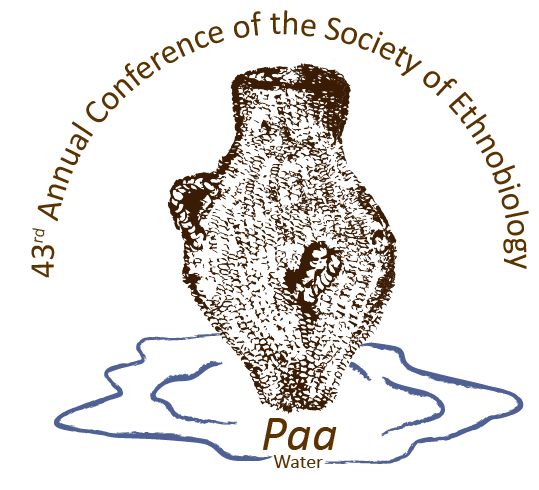Autumn 2019
Ethnobiology Newsletter

Society of Ethnobiology Member Newsletter
Message from the PresidentHello, and welcome to the Society of Ethnobiology’s Newsletter! We are re-invigorating this circular to members in the hopes of keeping in touch with Society news, and keeping some of the energy and connections we forged in Vancouver alive during the year. We hope you all had a great summer, whether this took you away to research trips and vacations, or if you—like me—mostly stayed put and used the summer months to teach, write, and do research. In this newsletter, you’ll find out about what’s been happening on the Ethics and Advocacy committee, and an invitation to view and comment on our Code of Conduct. You’ll see what research has been published in the Journal of Ethnobiology—check out the new “Ethnobiology in Song” edited volume!—and Ethnobiology Letters as well as our Forage! blog. We also invite you to nominate yourself or a colleague to join the Board, with elections to take place this fall. Open positions include: Publications Liaison, and Web and Social Media Liaison. More details on these positions can be found on our website. Also, keep an eye out for calls for applications for scholarships, fellowships, and nominations for our Distinguished Ethnobiologist award. As I’m writing, the UN General Assembly is meeting and the week of Climate Action is underway. I know our membership is deeply engaged in research and activism around climate change, and we have personal and professional engagement in climate justice. This community means so much to me and I’m grateful for your dedication to protecting natural resources and fighting for the rights of land and water caretakers around the world. In solidarity, and with love, |
Society of Ethnobiology Announcements

- Mark your calendars—SoE 43rd Annual Conference is in Cedar City, Utah May from 13–16, 2020 | The artist of the 2020 logo is Tanayah Tom. She is a member of the Indian Peaks Band of the Paiute Indian Tribe of Utah. Paa yoo-ants (Water Basket) is a source of life for the Nuwuvi, Southern Paiute people. Paa (water) is a precious resource that every living creature needs to sustain life.
- Please consider joining the SoE Board as a Member at Large! Two positions will be up for election this fall: Web and Social Media Liaison, and Publications Liaison. Find out more about these positions on our website. Email president@ethnobiology.org to forward your name or to nominate someone.
- The Ethics and Advocacy committee has been hard at work drafting a Code of Conduct for the Society, building off feedback obtained through workshops run at the 2019 meeting in Vancouver. We are now soliciting feedback from the membership. Please read our draft Code of Conduct and return any feedback to our President and Chair of the Ethics and Advocacy Committee, Sarah Walshaw. Review the first draft of the Code of Conduct here.
- Graduate fellowship deadlines are approaching! Applications are due by Nov. 15, 2019.
- Intergovernmental Science-Policy Platform on Biodiversity and Ecosystem Services (IPBES) is seeking comments from external reviewers for IPBES Assessment: Sustainable Use of Wild Species. Society members were especially invited to register to contribute to this process. Please visit their website for further information.
Journal of Ethnobiology Highlights
Special Issue Ethnobiology of Song
2019 Volume 39, Number 3
Ethnobiology of Song
By: Álvaro Fernández-Llamazares, Dana Lepofsky
“Research articles in this special issue illustrate the importance of songs as both a repository of ethnobiological knowledge and as a means to construct, maintain, and mobilize peoples’ intimate relations with their local ecologies. Although many traditional music-making systems are under risk of attrition, the extent to which traditional songs continue to be performed and celebrated in many Indigenous and local communities attests not just to the endurance and resilience of their cultures, but also to their deep cultural attachment to their lands as manifested through song.”
Journal of Ethnobiology
Autumn 2019 Metrics
Impact Factor (2018): 1.195
Forage! Blog Highlights
On Point (And Not NPR): Ancient Tattooing in the Southwestern United States
By: Andrew Gillreath-Brown
“Prickly pear cactus was one of the most common types of cacti used for tattooing, which is documented among at least 9 Indigenous Peoples in the region. Most of the cactus spine tattoo tools are multi-pointed (two or more spines). Tattoo inks varied across the region, and included materials such as charcoal (from many different plants), red and black minerals, red clay, plant pigments, iron, and red ochre.” Want to Read more? Visit https://ethnobiology.org/forage
|
CALL FOR SUBMISSIONS The Journal of Ethnobiology and Ethnobiology Letters are now accepting submission of manuscripts for the next edition. Please visit journalofethnobiology.org and ethnobiologyletters.org for more details. |
|
Do you have anything you would like the community of Ethnobiologists to know? Would you like to share job postings, events, news articles, etc.? Please email sekulic.3@osu.edu with any comments, concerns, or additions. Society of Ethnobiology
Boston University Archaeology Room 345, 675 Commonwealth Ave. Boston, MA 02215 United States To opt-out of all future mailings from us, click here. |